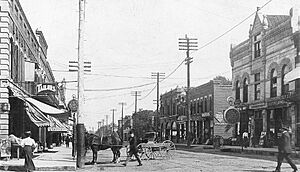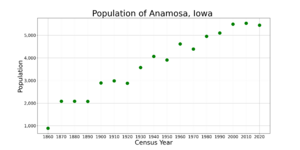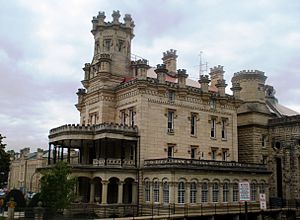Anamosa, Iowa facts for kids
Quick facts for kids
Anamosa, Iowa
|
||
|---|---|---|
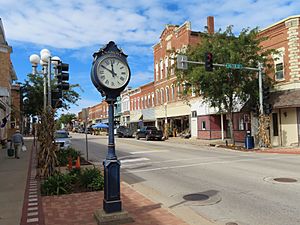
Anamosa, 2021
|
||
|
||
| Nickname(s):
A-Town
|
||
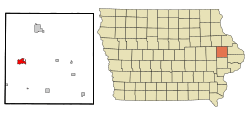
Location of Anamosa, Iowa
|
||
| Country | ||
| State | ||
| County | Jones | |
| Area | ||
| • Total | 2.53 sq mi (6.56 km2) | |
| • Land | 2.52 sq mi (6.54 km2) | |
| • Water | 0.01 sq mi (0.02 km2) | |
| Elevation | 830 ft (253 m) | |
| Population
(2020)
|
||
| • Total | 5,450 | |
| • Density | 2,159.27/sq mi (833.72/km2) | |
| Time zone | UTC-6 (Central (CST)) | |
| • Summer (DST) | UTC-5 (CDT) | |
| ZIP code |
52205
|
|
| Area code(s) | 319 | |
| FIPS code | 19-01990 | |
| GNIS feature ID | 0454176 | |
Anamosa is a city in Jones County, Iowa, United States. It is the county seat of Jones County. In 2020, about 5,450 people lived there. Anamosa is known for its interesting history and unique landmarks.
Contents
Anamosa's History and Name
The area now called Anamosa started as a settlement named Buffalo Forks in 1838. It became an official town called Lexington in 1856. However, many towns were named Lexington back then. To avoid confusion with mail, the name was changed to Anamosa in 1877.
How Anamosa Got Its Name
There are a few stories about how Anamosa got its name. One popular story says it was named after a young Native American girl. Her name was Anamosa, which might mean "white fawn" or "You walk with me."
In 1842, a Native American family stayed at the Ford House in town. The girl, Anamosa, was very kind and friendly. After her family left, the people of the town decided to name their home after her.
Anamosa's Special Nickname
In 1993, the Iowa State Legislature gave Anamosa a special title. It was named the "Pumpkin Capital of Iowa." Every October, the city hosts a big event called Pumpkinfest. This festival includes a pumpkin weigh-off, where people show off their giant pumpkins!
Geography and Location
Anamosa is located in eastern Iowa. The Wapsipinicon River flows right through the city. This river is an important natural feature of the area.
How to Get to Anamosa
You can reach Anamosa by major roads. U.S. Route 151 and Iowa Highway 64 both serve the city. This makes it easy for people to visit.
Population and People
Anamosa is part of the Cedar Rapids, Iowa metropolitan area. This means it's connected to a larger group of cities and towns.
Population Changes Over Time
The city's population has changed over many years. Here's a look at how many people have lived in Anamosa:
| Historical population | |||
|---|---|---|---|
| Census | Pop. | %± | |
| 1860 | 889 | — | |
| 1870 | 2,083 | 134.3% | |
| 1880 | 2,083 | 0.0% | |
| 1890 | 2,078 | −0.2% | |
| 1900 | 2,891 | 39.1% | |
| 1910 | 2,983 | 3.2% | |
| 1920 | 2,881 | −3.4% | |
| 1930 | 3,579 | 24.2% | |
| 1940 | 4,069 | 13.7% | |
| 1950 | 3,910 | −3.9% | |
| 1960 | 4,616 | 18.1% | |
| 1970 | 4,389 | −4.9% | |
| 1980 | 4,958 | 13.0% | |
| 1990 | 5,100 | 2.9% | |
| 2000 | 5,494 | 7.7% | |
| 2010 | 5,533 | 0.7% | |
| 2020 | 5,450 | −1.5% | |
| U.S. Decennial Census | |||
In 2010, there were 5,533 people living in Anamosa. About 1,941 households were in the city. The average household had about 2.25 people.
Who Lives in Anamosa?
Most people in Anamosa are White (91.1%). About 6.4% are African American. Smaller groups include Native American and Asian people. About 2.0% of the population is Hispanic or Latino.
The median age in Anamosa was 39.6 years in 2010. This means half the people were younger than 39.6, and half were older. About 19.6% of residents were under 18 years old.
Famous Places and Businesses
Anamosa has several interesting landmarks and industries.
Anamosa State Penitentiary
Anamosa is home to the Anamosa State Penitentiary. This is a large prison in Iowa. It was built in 1872 using local stone. The building looks like a castle, which is why it's sometimes called "The White Palace of the West." There is also a museum on the prison grounds. It shows artifacts and exhibits about prison life.
Motorcycle History
For many years, motorcycles were a big part of Anamosa. The city was home to J&P Cycles, a company that sold motorcycle parts. It also hosted the National Motorcycle Museum. This museum had over 300 old motorcycles. It even had a copy of the "Captain America bike" from the movie Easy Rider. Both of these closed in 2023.
Grant Wood, the Artist
Anamosa was the birthplace of a famous artist named Grant Wood. He is known for his unique paintings. His most famous work is American Gothic. You can see a collection of fun interpretations of his art at the Grant Wood Art Gallery in Anamosa. Grant Wood is buried in Riverside Cemetery in Anamosa.
Stone City and Wapsipinicon State Park
A few miles from Anamosa is the small community of Stone City. Grant Wood painted some of his pictures there. You can still see old buildings made from local stone.
Wapsipinicon State Park is on the edge of Anamosa. It's a great place for outdoor activities. The Hale Bridge is located inside the park. This bridge was moved to the park by helicopter!
Education in Anamosa
The Anamosa Community School District runs the public schools in the area. There is also a private school called St. Patrick School. It is part of the Roman Catholic Archdiocese of Dubuque and opened in 1944.
Notable People from Anamosa
Many interesting people have connections to Anamosa. Here are a few:
- Edmund Booth – A pioneer who helped start Anamosa. He was also a newspaper editor.
- Sarah Corpstein – She was named Miss Iowa USA in 2006.
- Clem F. Kimball – He served as the Lieutenant Governor of Iowa.
- Andy McKean – An Iowa State Representative.
- Scott Newhard – Another Iowa state representative.
- Don Norton – A professional football player for the San Diego Chargers.
- Lawrence Schoonover – An American novelist.
- Grant Wood – The famous artist mentioned earlier.
- Marshal Yanda – A longtime offensive lineman for the Baltimore Ravens football team.
See also
 In Spanish: Anamosa para niños
In Spanish: Anamosa para niños



